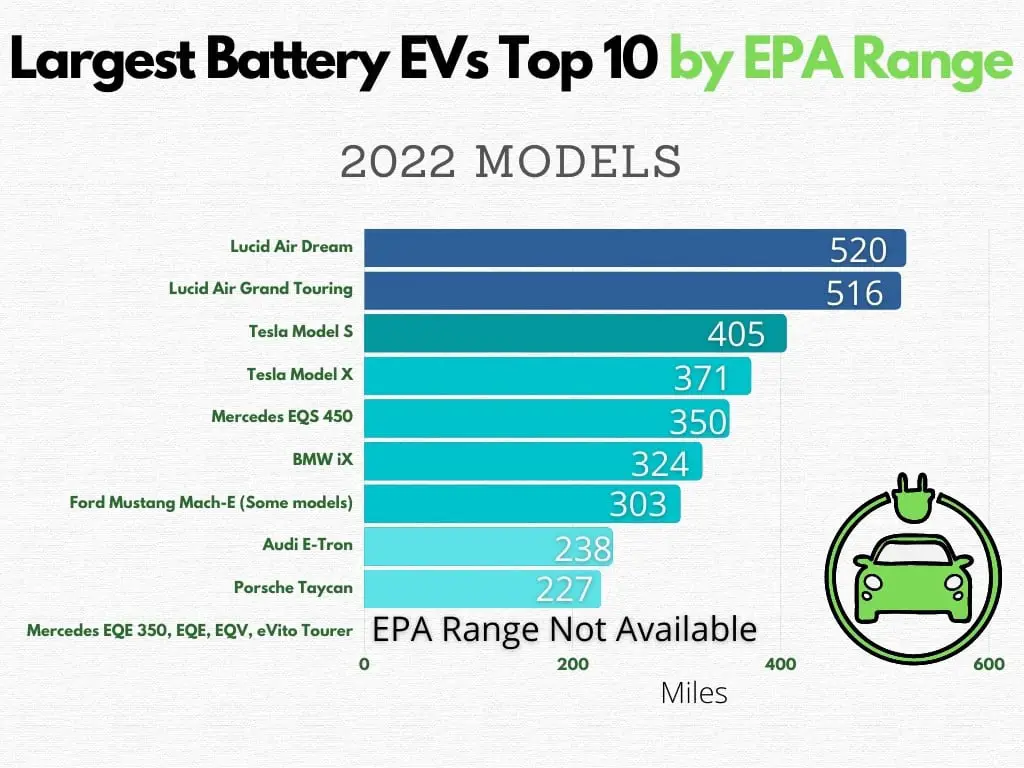Anyone looking into purchasing their first (or next) electric vehicle is concerned about battery size and range. Though one is not necessarily indicative of the other, they still hold weight in people’s minds when making a decision about their next purpose.
As of 2022, the electric vehicle with the biggest battery is the Lucid Air Dream Edition with a 118kWh usable battery and a an EPA estimated range of 520 miles (837km) power by Lucid Motors. Also above the 100kWh mark are the Lucid Air Grand Touring with 112kWh, the Mercedes EQS 450 with 107.8kWh, and the BMW iX with 105.2kWh of usable battery.
Let’s take a look at the Top 15 2022 model EVs with the largest batteries, discuss why a larger battery doesn’t necessarily mean a longer range, how many miles of travel you can expect per 1 kWh of battery power, and the average EV battery size.
Electric Vehicles with the Biggest Batteries (2022 Models)
| Make and Model EV | Year | Usable Battery kWh |
|---|---|---|
| Lucid Air Dream | 2022 | 118 |
| Lucid Air Grand Touring | 2022 | 112 |
| Mercedes EQS (450 and higher subvariants) | 2022 | 107.8 |
| BMW iX | 2022 | 105.2 |
| Tesla Model S | 2022 | 98 |
| Tesla Model X | 2022 | 95 |
| Audi E-Tron | 2022 | 91.5 |
| Ford Mustang Mach-E (Some models) | 2022 | 91 |
| Mercedes EQE 350, EQE, EQV, eVito Tourer | 2022 | 90 |
| Porsche Taycan | 2022 | 83.7 |
| Tesla Model 3 Extended Range | 2022 | 82 |
| BMW i4 | 2022 | 81.5 |
| Kia EV6 | 2022 | 77.4 |
| VW ID 4 | 2022 | 77 |
| Tesla Model Y | 2022 | 75 |
Larger Battery Doesn’t Mean Longer Range
As you’ll be able to see, just because an electric vehicle has a larger battery than another does not mean that it will be able to travel farther.
Every vehicle will have its own efficiency rating. In the USA we rate them with EPA MPGe (Miles per Gallon Equivalent), as well as the kilowatt-hours used per 100 miles. Europe will use WLTP (Worldwide Harmonised Light Vehicle Test Procedure) and NEDC (New European Driving Cycle).
A electric vehicle with a higher MPGe is more efficient when compared to an electric vehicle with a lower MPGe.
An electric vehicle with a lower kilowatt-hours used per 100 miles is more efficient than one with a higher one.

If we get back to our main point, let’s say a vehicle shaped like a big, blocky Jeep with no regards to aerodynamics is equipped with a large battery of 110kWh, and it goes up against a sleek Tesla Model S with a battery of 98kWh. The Tesla is going to have longer range every time.
You can see examples of this with the bar graphs above and below. The top bar graph will show the top 10 electric vehicles in 2022 as far as battery size, and the bottom graph will show how these same vehicles rank with regards to their EPA range tests.
In the real world, the weight of the vehicle (the EV itself, plus occupants and cargo), the shape of the vehicle (aerodynamics, profile, etc.), temperature, wheel size (smaller diameter wheels get longer range), and more all affect how far a vehicle can travel per 1 kilowatt hour of battery power.

How Many Miles of Range do you get per kWh of Battery?
As a general rule, an electric vehicle will get 3 to 5.5 miles of range per 1kWh of battery power. An EV will generally experience higher mileage per 1kWh when used for city driving versus highway driving.
You can calculate this number for your particular EV in one of two ways.
Method 1:
- Find the Combined EPA MPGe rating on the Monroney sticker that came with your EV, from fueleconomy.gov, or from insideevs.com
- Divide the combined MPGe by 33.7 (33.7kWH = 1 gallon of gas as far as energy)
Method 2:
- Find the kWh per 100 miles rating on the Monroney sticker that came with your EV, from fueleconomy.gov, or from insideevs.com
- Divide the kWh per 100 miles into 100
Example:
Let’s

- 99 MPGe / 33.7 = 2.94 miles per 1kWh of battery power
- 100 / 34 kWh per 100 miles = 2.94 miles per 1kWh of battery power
Do Bigger EV Batteries Take Longer to Charge?
Bigger electric vehicle batteries will take longer to charge when compared to a smaller battery and charged at the same charging speeds.
I have a full article here that was written for the beginner in mind that explains Level 1, Level 2, Level 3 charging, as well as how to easily calculate them yourself.
If you use Level 1 charging, which is done at 120-volts, then this could amount to a few extra hours to days, depending on the vehicle. A Nissan Leaf with an empty 40kWh battery at Level 1 charging could take 24 hours to charge at 20-amps and 120-volts, whereas a Tesla Model X with a 95kWh empty battery could take 62 hours to charge.
The same pattern applies as you move up to Level 2 charging and then to Level 3. As you increase the level of charge, the time difference becomes less in duration since all of the charging speeds are faster.
The difference in Level 2 charging between the same aforementioned vehicles could be 7 hours for the Nissan Leaf at 40-amps and 240-volts, whereas the Tesla Model X would take 16 hours.
When we move up to Level 3 charging, the difference in charging times between different battery sizes reduces to minutes.

